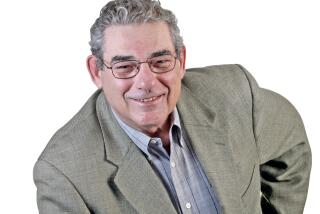Flamboyant Newspaper Editor Scott Newhall, 78
- Share via
Scott Newhall, the colorful editor whose flamboyant brand of journalism helped shape a growing Santa Clarita Valley and resurrected a slumbering San Francisco Chronicle, died Monday at a Valencia hospital.
The irreverent Newhall, who died at Henry Mayo Newhall Memorial Hospital--a hospital founded by and named after his great-grandfather--was 78. He had been suffering from acute pancreatitis.
Scion of the pioneer Newhalls, whose holdings included the Newhall Land & Farming Co., Newhall brought a flair for the unusual to his newspapers.
He began as a photographer on the Chronicle in 1934 when he was only 20 and by 1952 had become executive editor. When he left in 1971, his legacy included a series of zany stories including several about the Society for Indecency to Naked Animals that advocated clothing the “vital areas” of domesticated pets.
Newhall also sent a reporter to Mexico to find where Pancho Villa’s head was buried and ran headlines such as “A Great City Forced To Drink Swill,” to protest what he considered the poor quality of coffee served in San Francisco.
Part of his campaign to boost circulation also included a camel race and a treasure hunt with a $1,000 prize.
During his reign, Newhall was able to lure back to the Chronicle columnist Herb Caen, who was writing for the Examiner at the time.
Newhall also helped develop other columnists, including Arthur Hoppe, Stanton Delaplane, Charles McCabe and Count Marco, who gave unsolicited advice to women.
Ten years after Newhall took over as executive editor, circulation was up to nearly 400,000, moving the paper into San Francisco’s top newspaper spot.
“Scott Newhall was the definition of legend,” said William German, the current executive editor at the Chronicle.
“He enriched the West, the city of San Francisco, the Chronicle and life itself for so many of us. He will be remembered so long as there is history,” German said.
After his career in the Bay Area, where he was born and later ran an unsuccessful campaign for mayor, he went to the city that bore his family’s name and was editor with his wife, Ruth, of the Newhall Signal, which he had purchased while he was still in San Francisco.
(His great-grandfather had bought 47,000 acres of land in the Santa Clarita Valley for $90,000 in January, 1875, and founded the communities of Newhall and Saugus.)
Scott Newhall’s 19th Century-style editorials were prominently displayed on the front page of the community newspaper until his departure in a stock dispute in 1988. He brought to the smaller paper the same impiety that marked his reign in San Francisco.
He once wrote that the state Legislature is “a whining, lying, groveling gang of sneak thieves” and advised Los Angeles County Sheriff Sherman Block to “send his jolly hog callers to some duly-accredited charm school.”
The San Fernando Valley was characterized as “a heaven on earth for winos, dog prisoners, child abusers, husband swappers, wife-beaters, porno stars, bill jumpers, street racers, defrocked priests and street-corner bordellos.”
With his son Tony as publisher, the Signal became either the best-loved or most despised newspaper in town, depending on whose ox was being gored.
Despite the vitriol, it was Newhall who penned persuasive editorials that helped Santa Clarita gain its cityhood in 1987. He also rallied against a hazardous-waste facility near the valley’s drinking water wells in 1970.
Newhall had thrived on the edge of trouble since a boy.
He lost his right leg after he was kicked by a horse in a Mexican jungle, was expelled from one prep school for distilling grain alcohol in his chemistry class and from another for organizing prizefights.
After his family lost most of its money in the Depression, he attended UC Berkeley, quitting in 1933 at 19 to elope with Ruth Waldo, a secretary in the art department at the Chronicle. He had no photographic experience but talked his way into a photography job at the Chronicle, progressing to the library, the Sunday section and finally to a variety of editing positions before becoming executive editor.
Newhall’s home in the Ventura County town of Piru, about 20 miles west of Newhall, was as flamboyant as his writing. Called the “Poor Man’s Hearst Castle” or just simply “The Mansion,” the three-story Victorian home includes an antique piano and a piece of a tugboat that Newhall once skippered from London to San Francisco.
Above their bed, the Newhalls installed a large painting portraying a 1981 blaze that burned the house to the ground. It was rebuilt “perfectly. Except this time the plumbing works,” Newhall said.
“I never got a diploma except for a certificate in welding from the Samuel Gompers Trade School,” Newhall said in a long-ago interview. “I always seemed to quit just before final exams.”
Besides his wife and son Tony, Newhall is survived by two other sons, Skip and Jon, five grandchildren and one great-grandchild.
A memorial service will be held at 2 p.m. Sunday at the Piru Mansion. In lieu of flowers, the family asks that donations be made to the H.M. Newhall Foundation, 3 Embarcadero Center, Suite 2100, San Francisco 94111.
Times staff writer Nieson Himmel contributed to this obituary.
More to Read
Sign up for Essential California
The most important California stories and recommendations in your inbox every morning.
You may occasionally receive promotional content from the Los Angeles Times.













